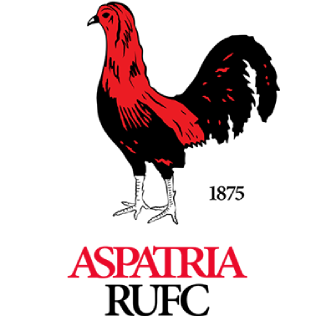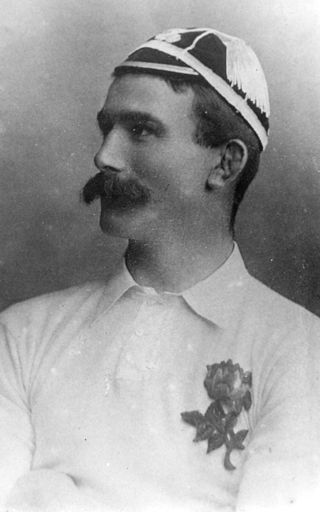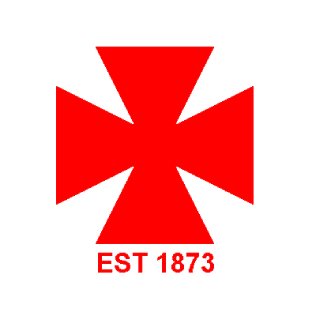
Aspatria is a town and civil parish in Cumberland, Cumbria, England. The town rests on the north side of the Ellen Valley, overlooking a panoramic view of the countryside, with Skiddaw to the South and the Solway Firth to the North. Its developments are aligned approximately east–west along the A596 Carlisle to Workington road and these extend to approximately 2 miles (3.2 km) in length. It lies about 8 miles (13 km) northeast of Maryport, a similar distance to the Southwest of Wigton, about 9 miles (14 km) north of Cockermouth and 5 miles (8.0 km) from the coast and Allonby. It comprises the townships of Aspatria and Brayton, Hayton and Mealo, and Oughterside and Allerby, the united area being 8,345 acres (3,377 ha); while the town takes up an area of 1,600 acres (647 ha). In earlier days a Roman road leading from "Old Carlisle" to Ellenborough passed through the hamlet.

Ronald 'Ronnie' William Poulton was an English rugby union footballer, who captained England. He was killed in the First World War during the Second Battle of Ypres.
The County Championship is an annual rugby union competition in England between teams representing English counties. After restructuring in 2007 the top tier of the Championship has been known as the Bill Beaumont Cup, after the trophy awarded to the competition winners was named in honour of Bill Beaumont, a former England and British & Irish Lions captain. In 2017 the competition was officially known as Bill Beaumont Division 1, with teams also competing in Division 2 and Division 3, which prior to 2017 were known as the Plate and Shield competitions.
James D. Metcalfe was an English rugby union, and professional rugby league footballer who played in the 1890s, 1900s and 1910s. He played representative level rugby union (RU) for Yorkshire, and at club level for Askam RUFC, Barnsley RUFC, and Featherstone RUFC, and representative level rugby league (RL) for Yorkshire, and at club level for Wakefield Trinity (captain), as a fullback.

James Wasdale Brough, also known by the nickname of 'Gentleman Jim' , was an English dual-code international rugby union, association football (soccer) footballer, and professional rugby league footballer who played in the 1920s and 1930s, and rugby league coach of the 1940s and 1950s. He played representative level rugby union (RU) for England and Cumberland, and at club level for Silloth RUFC, as a fullback, and club level association football as an amateur for Liverpool, as a goalkeeper, and representative level rugby league (RL) for Great Britain (captain), and England, and at club level for Leeds, as a fullback, or centre, and coached representative level rugby league (RL) for Great Britain, and at club level for Batley and Workington Town. Born in Silloth, Cumberland, England, he died in Workington, Cumbria, England.

Thomas Edwin Holliday, also known as "Tom" or "Tosh", was an English rugby union, and professional rugby league footballer who played in the 1920s. He was a dual-code international, playing for the England national rugby union team, British Lions, and the England national rugby league team.

Aspatria Rugby Union Football Club is an English rugby union club based in Aspatria, Cumbria in north west England, not far from the Scottish Border. They are nicknamed the "Black Reds", and have a red cockerel as their logo.

Joseph A.S. Davidson was an English sportsman.

Joseph H. Blacklock was an English rugby football player.
David Graham was an English rugby football player, from Aspatria, in Cumberland.

James Davidson was an English Rugby Union Football international who came from Aspatria, in Cumberland, Davidson was a stonemason and a builder by trade.
Frederick William Ashworth, also known by the nickname of "Basher", was an English rugby union and professional rugby league footballer who played in the 1920s and 1930s. He played club level rugby union (RU) for Aspatria RUFC, and representative level rugby league (RL) for Cumberland, and at club level for Oldham, as a forward, after retiring as a player he served Oldham as a member of the club's committee.
North 1 West is a rugby union league at the sixth level within the English league system. The league is made up of teams from north west England and the Isle of Man; principally consisting of the English counties of Cheshire, Cumbria, Greater Manchester, Lancashire and Merseyside. The league was known as North Division 2 when it was first created back in 1987 and was a single division. It has since split into two regional leagues, with North West 1 and its compatriot North 1 East being the longest running versions of the division.
David Pears is a former English rugby union player, who played for Harlequins and England. He played as a fly-half. He won 4 England caps, the first two on the 1990 England rugby union tour of Argentina, came on as a replacement during the 1992 Six Nations match against France and started at full back against France two years later.
North Lancashire/Cumbria was an English Rugby Union League at the seventh tier of club rugby union for teams from North Lancashire and Cumbria that ran until the end of 2017–18 season. Promotion from this division used to be into North 1 West with the champions going straight up and the league runners up facing the league runners up from South Lancs/Cheshire 1 for their place. Clubs at the bottom of the table were relegated either to North Lancashire 1, South Lancs/Cheshire 2 or the Cumbria League depending on their geographical location.
The Cumbria Rugby Union is the governing body for the sport of rugby union in the county of Cumbria in England. The union is the constituent body of the Rugby Football Union (RFU) for Cumbria, and administers and organises rugby union clubs and competitions in the county. It also administers the Cumbria rugby representative teams.
The Cumbria Cup is an annual rugby union knock-out club competition organized by the Cumbria Rugby Union. It was first introduced during the 1882-83 season, when it was known as the Cumberland Challenge Cup, and the inaugural winners were Aspatria. Originally it was open only to club sides in Cumberland, but in 1974, as a result of the 1972 Local Government Act, Cumberland, Westmorland and Furness merged to form what we now know as Cumbria, and the competition was renamed as the Cumbria Cup, although the Westmorland & Furness Cup continued intermittently up until 2008. It is the most important cup competition in the county ahead of the Cumbria League Cup and Cumbria Shield.
The Cumbria Shield is an annual rugby union knock-out club competition organized by the Cumbria Rugby Union. It was introduced during the 1888–89 season, when it was known as the Cumberland Challenge Shield, and the inaugural winners were Millom. Initially it was open only to junior club sides in Cumberland but in 1974, as a result of the 1972 Local Government Act, Cumberland, Westmorland and Furness merged to form what we now know as Cumbria, and the competition would ultimately be renamed as the Cumbria Shield. It is the third most important cup competition in Cumbria, behind the Cumbria Cup and Cumbria League Cup.

Workington RFC, also known as Workington Zebras, is an English rugby union club that is based in the town of Workington in Cumbria. The club operates four men's teams, a ladies teams and four boy's junior teams. The men's 1st XV currently play in Counties 1 Cumbria - a level 7 league in the English rugby union system. They play home games at the Ellis Sports Ground.

Carlisle Rugby Club is an English rugby union club based in Carlisle, Cumbria. The first XV team currently plays in Counties 1 Cumbria and in 2023–24 will celebrate their 150th anniversary season. As well as a 1st XV, the club also operates men's 2nd XV (Crusaders), an occasional 3rd XV (Hornets) side, a Colts (under-18), a women's side (Cougars), and a number of junior sides for boys and girls aged 6 to 16.










